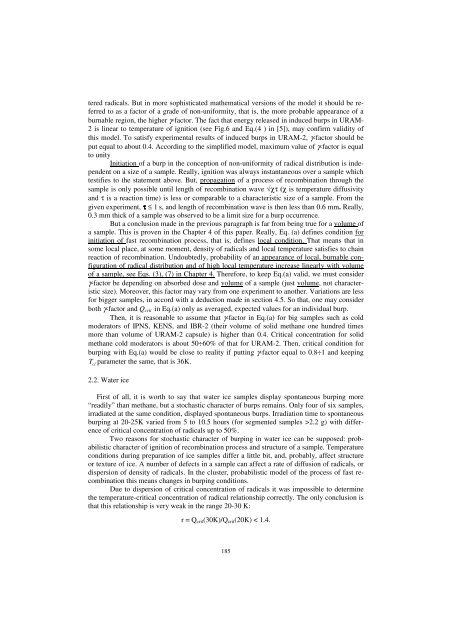Druck-Materie 20b.qxd - JUWEL - Forschungszentrum Jülich
Druck-Materie 20b.qxd - JUWEL - Forschungszentrum Jülich
Druck-Materie 20b.qxd - JUWEL - Forschungszentrum Jülich
You also want an ePaper? Increase the reach of your titles
YUMPU automatically turns print PDFs into web optimized ePapers that Google loves.
tered radicals. But in more sophisticated mathematical versions of the model it should be referred<br />
to as a factor of a grade of non-uniformity, that is, the more probable appearance of a<br />
burnable region, the higher γ-factor. The fact that energy released in induced burps in URAM-<br />
2 is linear to temperature of ignition (see Fig.6 and Eq.(4 ) in [5]), may confirm validity of<br />
this model. To satisfy experimental results of induced burps in URAM-2, γ-factor should be<br />
put equal to about 0.4. According to the simplified model, maximum value of γ-factor is equal<br />
to unity<br />
Initiation of a burp in the conception of non-uniformity of radical distribution is independent<br />
on a size of a sample. Really, ignition was always instantaneous over a sample which<br />
testifies to the statement above. But, propagation of a process of recombination through the<br />
sample is only possible until length of recombination wave √χτ (χ is temperature diffusivity<br />
and τ is a reaction time) is less or comparable to a characteristic size of a sample. From the<br />
given experiment, τ≤ 1 s, and length of recombination wave is then less than 0.6 mm. Really,<br />
0.3 mm thick of a sample was observed to be a limit size for a burp occurrence.<br />
But a conclusion made in the previous paragraph is far from being true for a volume of<br />
a sample. This is proven in the Chapter 4 of this paper. Really, Eq. (a) defines condition for<br />
initiation of fast recombination process, that is, defines local condition. That means that in<br />
some local place, at some moment, density of radicals and local temperature satisfies to chain<br />
reaction of recombination. Undoubtedly, probability of an appearance of local, burnable configuration<br />
of radical distribution and of high local temperature increase linearly with volume<br />
of a sample, see Eqs. (3), (7) in Chapter 4. Therefore, to keep Eq.(a) valid, we must consider<br />
γ-factor be depending on absorbed dose and volume of a sample (just volume, not characteristic<br />
size). Moreover, this factor may vary from one experiment to another. Variations are less<br />
for bigger samples, in accord with a deduction made in section 4.5. So that, one may consider<br />
both γ-factor and Qcrit in Eq.(a) only as averaged, expected values for an individual burp.<br />
Then, it is reasonable to assume that γ-factor in Eq.(a) for big samples such as cold<br />
moderators of IPNS, KENS, and IBR-2 (their volume of solid methane one hundred times<br />
more than volume of URAM-2 capsule) is higher than 0.4. Critical concentration for solid<br />
methane cold moderators is about 50÷60% of that for URAM-2. Then, critical condition for<br />
burping with Eq.(a) would be close to reality if putting γ-factor equal to 0.8÷1 and keeping<br />
T parameter the same, that is 36K.<br />
cl<br />
2.2. Water ice<br />
First of all, it is worth to say that water ice samples display spontaneous burping more<br />
“readily” than methane, but a stochastic character of burps remains. Only four of six samples,<br />
irradiated at the same condition, displayed spontaneous burps. Irradiation time to spontaneous<br />
burping at 20-25K varied from 5 to 10.5 hours (for segmented samples >2.2 g) with difference<br />
of critical concentration of radicals up to 50%.<br />
Two reasons for stochastic character of burping in water ice can be supposed: probabilistic<br />
character of ignition of recombination process and structure of a sample. Temperature<br />
conditions during preparation of ice samples differ a little bit, and, probably, affect structure<br />
or texture of ice. A number of defects in a sample can affect a rate of diffusion of radicals, or<br />
dispersion of density of radicals. In the cluster, probabilistic model of the process of fast recombination<br />
this means changes in burping conditions.<br />
Due to dispersion of critical concentration of radicals it was impossible to determine<br />
the temperature-critical concentration of radical relationship correctly. The only conclusion is<br />
that this relationship is very weak in the range 20-30 K:<br />
r = Qcrit(30K)/Qcrit(20K) < 1.4.<br />
185

















